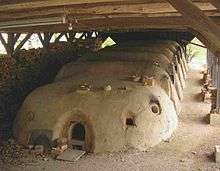Dragon kiln


A dragon kiln or "climbing kiln", long in Chinese, is a traditional Chinese form of kiln, used for Chinese ceramics, especially in southern China. It is long and thin, and relies on having a fairly steep slope, typically between 10° and 16°,[1] up which the kiln runs. The kiln could achieve the very high temperatures, sometimes as high as 1400° Centigrade,[2] necessary for high-fired wares including stoneware and porcelain, which challenged European potters of the same period, and some examples were very large, allowing up to 25,000 pieces to be fired at a time,[3] and up to 60 metres long.[4] By the early 12th century CE they might be over 135 metres long, allowing still larger quantities to be fired.[5]
History
According to recent excavations in Shangyu District in the northeast of Zhejiang province and elsewhere, the origins of the dragon kiln may go back as far as the Shang dynasty (c. 1600 to 1046 BCE), and is linked to the introduction of stoneware, fired at 1200° or more. These kilns were much smaller than later examples, at some 5-12 metres long, and also sloped far less.[6]
The type had certainly developed by the period of the Kingdom of Wu, 220-280 CE, perhaps at Shangyu, where there were over 60 kilns by 200 CE. Thereafter it remained the main design used in southern China until the Ming dynasty. The pottery areas of south China are mostly hilly, whereas those on the plains of north China typically lack suitable slopes; here the mantou kiln type predominated.[7]
The Nanfeng Kiln in Guangdong province is several centuries old and still functioning. It was a producer of Shiwan ware as well as architectural ceramics, and today also functions as a tourist atraction.[8]
Characteristics

The kilns were normally made of brick, and are one type of "cross-draught" kilns, where the flames travel more or less horizontally, rather than up from or down to the floor.[9] Early kilns were rising tunnels, not divided into chambers, but with a step at intervals giving relatively flat floor levels, and perhaps using gravel or similar material on the floor to allow vertical stacks to be rested. From the Southern Song period (1127–1279), some kilns were built as a series of chambers, stepped as they ran up the slope,[10] and with connecting doors to allow access to both the kiln-workers during loading and unloading, and the heat during firing. There might be up to 12 chambers.[11] Chambered kilns were usual for making Longquan celadon[12]
The main fire chamber was at the bottom, but there might be additional "stoke holes" to allow adding extra fuel at intervals up the slope, as well as peep holes to allow sight of the interior. At the far, top, end there was a chimney, but given the up-draught of the slope, this did not need to be tall, and might be omitted altogether.[13] The size and shape of the kilns and chambers within varied considerably. Firing was begun at the bottom end and moved up the slope.[14] The fuel might be wood or (generally less often) coal, which affected the atmosphere of the firing; wood giving a reducing atmosphere and coal an oxidizing one.[15] Generally saggars were used,[16] at least in later periods. These were an innovation of Ding ware from the north in the Song dynasty.[17]
The kilns allowed large quantities of pottery to be fired at high temperatures, but the firing was not usually even across the length of the kiln, which often produced different effects on pieces at different levels. Very often the higher chambers produced the better pieces, as they heated up more slowly.[18] As one example, the wide range of colours seen in Chinese celadon wares such as Yue ware and Longquan celadon is largely explained by variations in firing conditions.[19] Variations in the shades of white porcelains between and within the northern Ding ware and the southern Qingbai were also the result of the fuel used.[20] Some of the most advanced chambered kilns were built to fire Dehua porcelain, where precise control of high temperatures was essential.[21] The dragon kiln form was copied in Korea, from sometime between 100-300 CE, and much later in Japan in various types of climbing anagama kilns, and elsewhere in East Asia.
Notes
- ↑ Vainker, 222
- ↑ Medley, 14
- ↑ Medley, 14
- ↑ Vainker, 222
- ↑ Kerr, 348
- ↑ Kerr, 348-350
- ↑ Vainker, 50-51; Rawson, 364-365
- ↑ "Ancient Nanfeng Kiln", China Tour Advisors
- ↑ Rawson, 364; Wood
- ↑ Wood
- ↑ Medley, 14; Wood
- ↑ Vainker, 222
- ↑ Wood
- ↑ Medley, 147-148; Vainker, 222
- ↑ Vainker, 124
- ↑ Medley, 148
- ↑ Vainker, 95
- ↑ Medley, 147-148
- ↑ Vainker, 72
- ↑ Vainker, 95, 124
- ↑ Wood
References
- Kerr, Rose; Needham, Joseph; Wood, Nigel, Science and Civilisation in China: Volume 5, Chemistry and Chemical Technology, Part 12, Ceramic Technology, 2004, Cambridge University Press, ISBN 0521838339, 9780521838337, google books
- Medley, Margaret, The Chinese Potter: A Practical History of Chinese Ceramics, 3rd edition, 1989, Phaidon, ISBN 071482593X
- Rawson, Jessica (ed). The British Museum Book of Chinese Art, 2007 (2nd edn), British Museum Press, ISBN 9780714124469
- Vainker, S.J., Chinese Pottery and Porcelain, 1991, British Museum Press, 9780714114705
- Wood, Nigel: Oxford Art Online, section "Dragon (long) kilns" in "China, §VIII, 2.2: Ceramics: Materials and techniques, Materials and techniques".